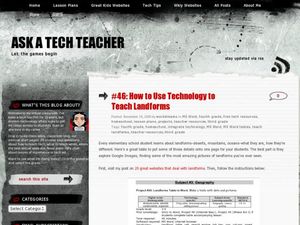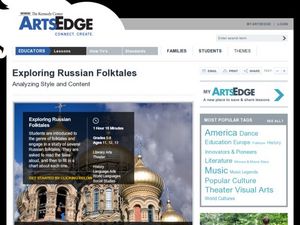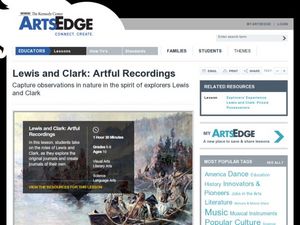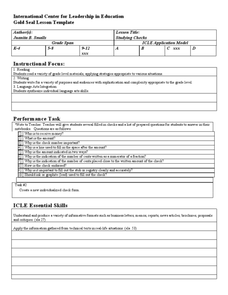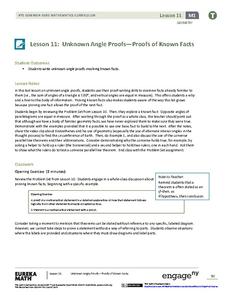Curated OER
Secret Services
Students examine news about an espionage case. They work in small groups to research espionage and spy trials of the Cold War era. Students create oral presentations detailing presentations in specific cases.
Curated OER
How to Use Technology to Teach Landforms
Students create a landform table on the computer. In this geography lesson, students use Microsoft Word to design a 3 column table. They list different landforms, examples, and attach a picture of each.
Curated OER
Exploring Russian Folktales
Students examine Russian Folktales. In this folklore lesson, students discuss the attributes of common folktales they know and then discover details regarding Russian folktales. Students read 3 folktales and then complete the provided...
Curated OER
Lewis and Clark: Artful Recordings
Students examine the nature journals of Lewis and Clark. In this primary source analysis lesson, students research the journals that the members of the Corps of Discovery kept during the expedition and then conduct further research on...
Curated OER
Transcendentalism and Epiphany in Ray Bradbury's Dandelion Wine
Twelfth graders examine the characteristics of transcendentalism. In this transcendentalism instructional activity, 12th graders determine what this type of writing entails before reading a passage from, Ray Bradbury's, Dandelion Wine....
Curated OER
Mystery Math
Here is an interesting "trick" your young mathematicians can perform. They are taught how to find any number's "digital root," by following a set of detailed instructions. The process works for any number, and is the type of math puzzle...
Curated OER
Studying Checks
While on-line banking and electronic payments seem to be the way of the future, next-generation wage earners still need to understand the details of check writing. Here the focus is on the details of the check including what the...
Curated OER
Computer Tracks Lunch Choices
Students read a story called Computer Program Tracks Lunch Choices and answer vocabulary and comprehension questions about it. For this current events literacy lesson plan, students respond to literature by answering questions, recalling...
Curated OER
Final Topic Selection
Read The Quicksand Book by Tomie dePaola while taking notes about the story. Perform a read-aloud, and work your way through the text with your youngsters. With this plan, learners also write about ideas from a previous day, and...
Curated OER
Telecommunication
Each of these slides has notes for a teacher to support the activities that are planned for the students. The slides give details and facts about sound waves. Although this slide show delivers useful information about the sound waves,...
Curated OER
Introductions and Conclusions
The format of the introduction and conclusion paragraphs in an expository essay are the focus of short presentation that details how to craft these all-important sections of a paper. No specific examples are included.
Curated OER
Exploring Infinite Series
Learners analyze geometric series in detail. They determine convergence and sum of geometric series, identify a series that satisfies the alternating series test and utilize a graphing handheld to approximate the sum of a series.
Curated OER
Social Studies: Aztec Calendars and Culture
Sixth graders analyze the Aztec calendar and create their own examples of them. They determine the meaning of the symbols used in the calendars and record their ideas in journals. Students host a parent breakfast for them to observe...
Curated OER
Notetaking Skills
Fifth graders review notetaking skills and brainstorm a list of times when notetaking is important. They review a given text then take notes on writing paper, using the modeled style.
Curated OER
Did Napoleon Uphold or Betray the Goals of the Revolution?
Walk your learners through constructing a well-formulated argument on Napoleon's dedication to the goals of the French Revolution.
Mathematics Vision Project
Geometric Figures
Logical thinking is at the forefront of this jam-packed lesson, with young mathematicians not only investigating geometric concepts but also how they "know what they know". Through each activity and worksheet, learners wrestle with...
Macmillan Education
Time Management
The benefits of good time management and the consequences for poor time management are the focus of a series of exercises designed for ELL/ELD classes but appropriate for all learners.
Curriculum Corner
Guest Teacher Plans: 1st Grade
Have you ever gone to work when you needed to stay home but didn't because the thought of making substitute plans was too daunting? Don't feel that way anymore with a template designed for first grade equipped with general classroom...
Ontario
Reading Informational Text
Learning to recognize the importance of the features of information text (i.e., titles, subtitles, endnotes, sidebars, etc.) is the focus of a reading activity designed for middle schoolers. Learners examine how these text features...
Teach Engineering
Study Design for Air Quality Research
Provide your class with the tools they need to design a research project. Groups examine case studies to gain information about the process involved in designing a research project. They use materials provided to brainstorm and develop a...
EngageNY
Unknown Angle Proofs—Proofs of Known Facts
Lead the class in a Greek history lesson with a geometric twist. Pupils relate a short video about geometric properties to modern-day methods of solving for unknown angles. They discuss parallel line theorems and complete...
Teach Engineering
Where Are the Plastics Near Me? (Field Trip)
With a piece of plastic here and a piece of plastic there, here a piece, there a piece, everywhere a piece. Teams go on a field trip in order to document the locations and kinds of plastic trash in an area near them. The eighth...
Savvas Learning
Passive Voice
Passive voice and participial adjectives are the focus of an 11-page resource packet designed for ESL/ELD classes. Language learners engage in activities and complete exercises that give them lots of practice with these constructs.
EngageNY
Translations
Learn through constructions! Learners examine a translation using constructions and define the translation using a vector. Pupils then construct parallel lines to determine the location of a translated image and use the vector as a guide.

